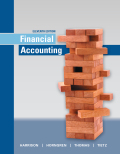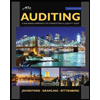
EBK FINANCIAL ACCOUNTING
11th Edition
ISBN: 8220101472007
Author: TIETZ
Publisher: PEARSON
expand_more
expand_more
format_list_bulleted
Textbook Question
Chapter 4, Problem 4.7S
(Learning Objective 3: Evalue internal controls over cash) Cash may be a small item on the financial statements. Nevertheless, internal control over cash is very important. Why is this true?
Expert Solution & Answer
Want to see the full answer?
Check out a sample textbook solution
Students have asked these similar questions
How much gain must be recognise on this conversion ?
I am searching for the correct answer to this general accounting problem with proper accounting rules.
Can you solve this general accounting problem with appropriate steps and explanations?
Chapter 4 Solutions
EBK FINANCIAL ACCOUNTING
Ch. 4 - Prob. 1QCCh. 4 - Prob. 2QCCh. 4 - Prob. 3QCCh. 4 - Prob. 4QCCh. 4 - Prob. 5QCCh. 4 - Prob. 6QCCh. 4 - Prob. 7QCCh. 4 - Prob. 8QCCh. 4 - Prob. 9QCCh. 4 - Prob. 10QC
Ch. 4 - Prob. 11QCCh. 4 - Prob. 4.1ECCh. 4 - Prob. 4.1SCh. 4 - Prob. 4.2SCh. 4 - Prob. 4.3SCh. 4 - (Learning Objective 2: Describe objectives and...Ch. 4 - Prob. 4.5SCh. 4 - (Learning Objective 2: Explain the objectives and...Ch. 4 - (Learning Objective 3: Evalue internal controls...Ch. 4 - Prob. 4.8SCh. 4 - Prob. 4.9SCh. 4 - Prob. 4.10SCh. 4 - Prob. 4.11SCh. 4 - Prob. 4.12SCh. 4 - Prob. 4.13SCh. 4 - Prob. 4.14SCh. 4 - Prob. 4.15SCh. 4 - Prob. 4.16AECh. 4 - Prob. 4.17AECh. 4 - Prob. 4.18AECh. 4 - Prob. 4.19AECh. 4 - Prob. 4.20AECh. 4 - Prob. 4.21AECh. 4 - Prob. 4.22AECh. 4 - Prob. 4.23AECh. 4 - Prob. 4.24AECh. 4 - Prob. 4.25BECh. 4 - Prob. 4.26BECh. 4 - Prob. 4.27BECh. 4 - Prob. 4.28BECh. 4 - Prob. 4.29BECh. 4 - Prob. 4.30BECh. 4 - Prob. 4.31BECh. 4 - Prob. 4.32BECh. 4 - Prob. 4.33BECh. 4 - Prob. 4.34QCh. 4 - Prob. 4.35QCh. 4 - Prob. 4.36QCh. 4 - Prob. 4.37QCh. 4 - Prob. 4.38QCh. 4 - Prob. 4.39QCh. 4 - Prob. 4.40QCh. 4 - Prob. 4.41QCh. 4 - Prob. 4.42QCh. 4 - Prob. 4.43QCh. 4 - Prob. 4.44QCh. 4 - Prob. 4.45QCh. 4 - Prob. 4.46APCh. 4 - Prob. 4.47APCh. 4 - Prob. 4.48APCh. 4 - Prob. 4.49APCh. 4 - Prob. 4.50BPCh. 4 - Prob. 4.51BPCh. 4 - Prob. 4.52BPCh. 4 - Prob. 4.53BPCh. 4 - Prob. 4.54CEPCh. 4 - Prob. 4.55CEPCh. 4 - Prob. 4.56CEPCh. 4 - Prob. 1DCCh. 4 - Prob. 2DCCh. 4 - Prob. 1EICh. 4 - Prob. 1FFCh. 4 - Prob. 1FA
Knowledge Booster
Learn more about
Need a deep-dive on the concept behind this application? Look no further. Learn more about this topic, accounting and related others by exploring similar questions and additional content below.Similar questions
- No WRONG ANSWERarrow_forwardI need help with this general accounting question using standard accounting techniques.arrow_forwardInnovations Inc. had a $38,000 beginning inventory and a $45,000 ending inventory. Net sales were $215,000; purchases were $110,000; purchase returns and allowances were $5,000; and freight-in was $9,000. Cost of goods sold for the period is $107,000. What is Innovations Inc.'s gross profit percentage?arrow_forward
- Could you help me solve this financial accounting question using appropriate calculation technical.arrow_forwardPlease provide the correct answer to this general accounting problem using accurate calculations.arrow_forwardPlease provide the solution to this general accounting question using proper accounting principles.arrow_forward
- Meagan Industries completes Job #843, which has a standard of 450 labor hours at a standard rate of $24.50 per hour. The job was completed in 420 hours, and the average actual labor rate was $25.20 per hour. What is the labor efficiency (quantity) variance?arrow_forwardSolve this Accounting Problemarrow_forwardHarmony Beverages produces a fruit juice blend using three ingredients: Apple, Orange, and Mango. The standard mix ratio is 50% Apple, 30% Orange, and 20% Mango. The standard cost per gallon is $2.00 for Apple, $3.50 for Orange, and $5.00 for Mango. Standard production calls for 100 gallons of ingredients to yield 95 gallons of finished juice due to waste. Last week, the company used 60 gallons of Apple, 25 gallons of Orange, and 20 gallons of Mango, which yielded 98 gallons of finished juice. Calculate the materials yield variance.arrow_forward
arrow_back_ios
SEE MORE QUESTIONS
arrow_forward_ios
Recommended textbooks for you
 Auditing: A Risk Based-Approach (MindTap Course L...AccountingISBN:9781337619455Author:Karla M Johnstone, Audrey A. Gramling, Larry E. RittenbergPublisher:Cengage Learning
Auditing: A Risk Based-Approach (MindTap Course L...AccountingISBN:9781337619455Author:Karla M Johnstone, Audrey A. Gramling, Larry E. RittenbergPublisher:Cengage Learning Cornerstones of Financial AccountingAccountingISBN:9781337690881Author:Jay Rich, Jeff JonesPublisher:Cengage Learning
Cornerstones of Financial AccountingAccountingISBN:9781337690881Author:Jay Rich, Jeff JonesPublisher:Cengage Learning Auditing: A Risk Based-Approach to Conducting a Q...AccountingISBN:9781305080577Author:Karla M Johnstone, Audrey A. Gramling, Larry E. RittenbergPublisher:South-Western College Pub
Auditing: A Risk Based-Approach to Conducting a Q...AccountingISBN:9781305080577Author:Karla M Johnstone, Audrey A. Gramling, Larry E. RittenbergPublisher:South-Western College Pub Intermediate Accounting: Reporting And AnalysisAccountingISBN:9781337788281Author:James M. Wahlen, Jefferson P. Jones, Donald PagachPublisher:Cengage Learning
Intermediate Accounting: Reporting And AnalysisAccountingISBN:9781337788281Author:James M. Wahlen, Jefferson P. Jones, Donald PagachPublisher:Cengage Learning

Auditing: A Risk Based-Approach (MindTap Course L...
Accounting
ISBN:9781337619455
Author:Karla M Johnstone, Audrey A. Gramling, Larry E. Rittenberg
Publisher:Cengage Learning

Cornerstones of Financial Accounting
Accounting
ISBN:9781337690881
Author:Jay Rich, Jeff Jones
Publisher:Cengage Learning

Auditing: A Risk Based-Approach to Conducting a Q...
Accounting
ISBN:9781305080577
Author:Karla M Johnstone, Audrey A. Gramling, Larry E. Rittenberg
Publisher:South-Western College Pub

Intermediate Accounting: Reporting And Analysis
Accounting
ISBN:9781337788281
Author:James M. Wahlen, Jefferson P. Jones, Donald Pagach
Publisher:Cengage Learning
Internal Control Components; Author: Accounting Instruction, Help, & How To;https://www.youtube.com/watch?v=D8SSaqpE6L8;License: Standard Youtube License